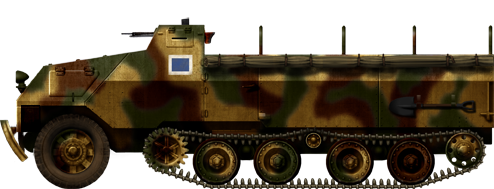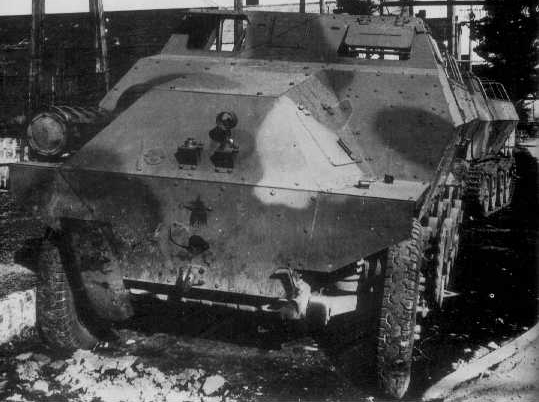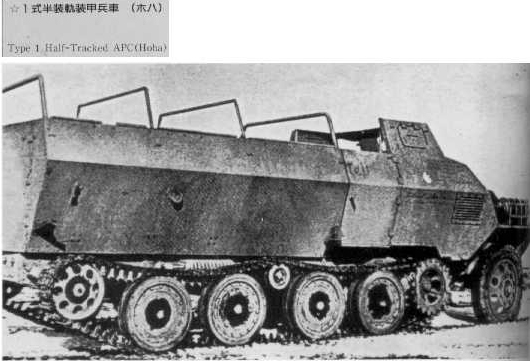The project began with a 1941 specification for a new armored personnel carrier (APC) and a heavy prime mover for the artillery. This was the response to reports stating the poor performance of armored carriers during the Sino-Japanese war, compared to trucks, and, at the same time, the limited off-road capabilities of the latter. The perfect compromise seemed to be an armored half-track. Hino Motors presented a prototype by late 1941, largely inspired by the German Sd.Kfz.251/1, more commonly known as the “Hanomag”. It was developed in parallel to the Type 1 Ho-Ki, which followed the same specification, but featured full tracks.
Design of the Type 1 Ho-Ha
The Type 1 Ho-Ha’s designation followed the new “imperial time” nomenclature, and was an abbreviate form of Ici-shiki han-soki soko-heisha hoha. The vehicle had a large, roomy hull and a pair of short symmetrical caterpillar tracks, with a single, central return roller each, and a bell crank suspension system. In fact, it could accommodate more soldiers than its German inspiration, following a 1941 specification to be able to transport an infantry squad. In addition to the steering wheel, the driver used a pair of levers, each operating a track brake. The welded hull, with sloped plates, was equipped with a towing hitch to haul light and medium artillery pieces, had a completely open-top, including the driver compartment. However, the entire length could be covered by a waterproof tarpaulin. It was lightly armored, 6 to 8 mm (0.24-0.31 in), enough to sustain small arms fire. Armament comprised two forward pintle mounts, placed just behind the driver compartment, equipped with a single Type 97 machine gun each. Another AA central mounting was placed at the rear end of the hull. All three had very limited traverse.
Uncertain, limited production
However, by 1942, the military lost interest in the project, due to its non-offensive nature and compatibility issues with the current doctrine. This reduced its priority, development dragged on and was nearly stopped. Therefore, no real mass-production could start before 1944, and by then it was severely limited, due to the lack of raw materials. In fact, no information remains from factory logs about the total delivered. Most sources don’t even mention a number. What is sure is that many were delivered to China and the Philippines, and were barely in sufficient numbers -taking in account the transport losses due to US Navy subs actions- to equip several infantry units.
Active service
Because of the late and limited production, the Ho-Ha had a limited impact by the time it arrived in operations. Only the success of its German counterpart and the shift from an offensive to largely defensive tactics, as well as a late doctrine change towards independently operating armored divisions, finally shifted the balance in favor of the Ho-Ki and Ho-Ha types. They were still designed as support units, and not for true “armored mechanized infantry”. The first ones delivered early in 1944 were shipped to China, were they remained until the end of the war. Others were later shipped to the Philippines, and at least saw action, showing excellent maneuverability and grip on all terrains and reasonable speed. On the other hand, their awkward machine-gun mounts had very limited arcs of fire, which doomed any reprisal against fast moving targets. The last delivered never left the islands and survived the war as civilian special-duty trucks, helping the reconstruction of devastated cities and access to remote areas, or as garbage trucks in Tokyo.
Links
The Ho-Ha on Wikipedia
The Type 1 on WWII Wiki
Type 1 Ho-Ha Specifications | |
| Dimensions (L-w-h) | 6.10 x 2.10 x 2.51 m (20 x 6.11 x 8.3 ft) |
| Total weight, battle ready | 6.5 tons |
| Crew | 3+12 passengers |
| Propulsion | Hino motors diesel, air-cooled 4-cyl, 134 hp@2000 rpm |
| Top speed | 50 km/h (31 mph) |
| Armor | 8 mm (0.31 in) |
| Armament | 3 x 7.7 mm (0.3 in) Type 97 machine-guns |
| Range (maximum at cruise speed) | 300 km (200 miles) |
| Total production | 150-300 built |

Type 1 Ho-Ha, attached to the 5th Tank Regiment (Sensha Rentai), Manchuria, August 1945.

Type 1 Ho-Ha with tarpaulin, Luzon island, December 1944.
Gallery

Front view of a Ho-Ha half-track.

Rear view of another Ho-Ha.

Get the Poster of the ww2 Imperial Japanese Army Tanks and support us !

WW2 Tanks




























WW2 tanks posters

All Tiger tanks liveries.

Panther liveries and variants

WW2 Armour - All tanks











Tanks aces and single tanks series

Find more there

Museums, Movies, Books & Games
The Tanks and Armor in pop culture
Tanks and armored vehicles in general are only really grasped when seen first person: The mass, the scale, it's all there. Explore also the way tanks were covered in the movie industry, in books and in video games.Movies:
Best tanks movie on warhistoryonline.com
On imdb.com
On bestsimilar.com/
miltours.com
liveabout.com/
watchmojo.com
Video Games:
pcgamesn.com
historyhit.com
levvvel.com
vg247.com/best-tank-games
mmobomb.com/
alienwarearena.com

